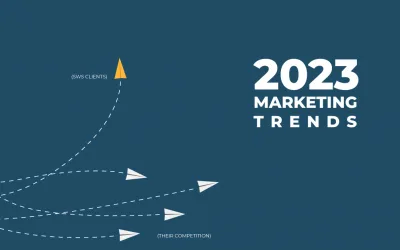When people aren’t scrolling through their social feeds, they’re probably searching for answers to their questions on Google. In fact, 93% of online experiences begin with a simple search query.
Between social platforms, search engines, blogs, online videos, podcasts, and physical behaviors, businesses need to establish a robust presence across the entire digital landscape in order to remain relevant and meet their objectives. This is why it’s critical for companies to take a multichannel marketing approach. By taking the time to develop a presence across multiple channels, businesses dramatically increase their chances of reaching the right consumer on the right platform at the right time.
First, What is Multichannel Marketing?
SAS’s definition of multichannel:
Multichannel marketing refers to the practice of interacting with customers using a combination of indirect and direct communication channels – websites, retail stores, mail order catalogs, direct mail, email, mobile, etc. –
Multichannel can also be integrated with an omnichannel approach defined by Emarsys as:
Omnichannel is a cross-channel content strategy used to improve the customer experience and drive better relationships across all possible channels and touchpoints. This includes traditional and digital channels, point-of-sale, and physical and online experiences.
Omnichannel marketing refers to the multichannel sales approach that provides the customer with an integrated shopping experience. The customer can be shopping online from a desktop or mobile device, via phone, or in a brick-and-mortar store, and the experience will be seamless.
We like to take this a step forward and blend the two into a comprehensive approach that uses multiple channels to tell a cohesive brand story.
Four Tips for Strengthening Multichannel Marketing in 2021
It might sound simple enough to achieve, but there are many factors to consider that determine how impactful the multichannel strategy will be. We’ve broken down everything you need to know about multichannel marketing to help you succeed in the new year.
Cohesive Messaging
Hands down, the biggest factor contributing to multichannel marketing success is telling a cohesive story. Businesses need to be strategic in their messaging, ensuring they remain consistent across each of their platforms.
Not only do the words used matter, but the visual cues related to a brand are important as well. Shapes, imagery, logos, brand colors, animations, and other visual elements all need to possess a unique, easily identifiable appearance to help businesses stand out from the crowded, competitive digital sphere.
Chain Messaging Together
Chaining cohesive messaging together refers to the practice of grouping content types together based on the campaign targets. Specific details, such as timing, content type, topic, and visuals should all be relevant to the specific campaign.
The ability to chain messaging together is incredibly important as brands strategize about their multichannel approach. Strategists need to consider the specific stage their target consumers may be at in the buying cycle when their marketing deliverables are seen. In order to accomplish this, businesses will first need to understand how most users leverage each platform to interact with brands.
For example, Facebook and Instagram users might not be present on the platform with the sole intent to make a purchase. Rather than delivering content that’s focused solely on conversions and sales, it may be more beneficial for brands to simply increase awareness by highlighting products and services.
By contrast, users entering a specific search query about a product or service your company offers may be ready to convert and make a purchase. Search engine marketing messaging should therefore focus on increasing the likelihood of conversion by targeting specific keywords and phrases.
Leverage Media & Audience Targeting Appropriately
Keeping with the theme of chaining cohesive messaging, brands need to ensure that they leverage media channels appropriately.
Not every platform can or should deliver the same message, every platform is dominated by its own unique user demographic, which significantly influences how different content types and topics perform across the platform.
In addition to platform considerations, businesses need to be mindful of their relationship with the audience at every stage in the journey. It wouldn’t make sense for a company to serve an ad to someone under the assumption that they’ve already been to their website when they haven’t.
That’s why many digital marketing platforms allow businesses to utilize pixels, conversion and page tracking so they can target (or even exclude) specific people who have interacted with their brand in the past. This helps businesses more easily reach the right people at the right time through their multichannel marketing efforts.
Build the Funnel & User Journey
The last step to winning at multichannel marketing in 2021 is building the funnel and user journey. When this is complete you will know what message to deliver to the audience at every interaction on their journey.
Once you understand where the audience lives, how different platforms are used, and what messaging is most effective on which channels, you’ll be better able to tailor ad sets to guide users through the consumer pipeline. When done correctly, you can ensure the right people see the right ad and are directed to the right part of your website.
For instance, a toy company might create a campaign targeted at new parents for the release of a new product. They could take a multichannel approach by leveraging Instagram, Facebook, Pinterest, and YouTube to deliver video campaigns with a link to the new product page.
The ad would only be delivered to people who meet their audience demographic criteria so only the users most likely to make a purchase are served the ad that takes them to the precise page they need.
Then, based on the engagement with the page, you can create a similar ad with a slightly different message that targets the same parent who saw the initial ad, clicked on the page, and maybe didn’t purchase. This message can be an “act now,” or potentially hitting them with alternative products they may be interested in.
Multichannel Digital Marketing for 2021 Success
Developing a multichannel marketing approach is more complex than it might initially sound, but when done correctly, it can be extremely effective.
By taking the time to understand each platform, identify the target audience, and develop cohesive messaging, brands can significantly increase their likelihood of meeting their business objectives in the new year.
Multichannel marketing takes a lot of time and energy to get just right, our advice is to start small and build out. Start with creating a basic 3-part funnel and buyer journey, identify what message each stage needs and what platform it is served in. You can then build out once you become more comfortable.




